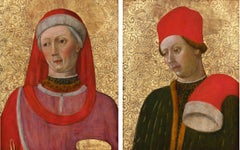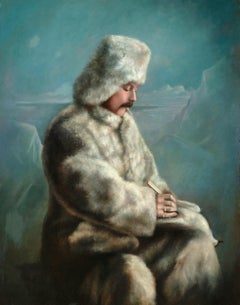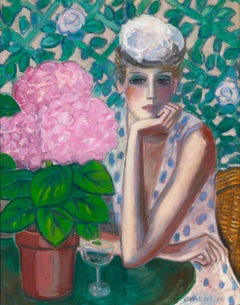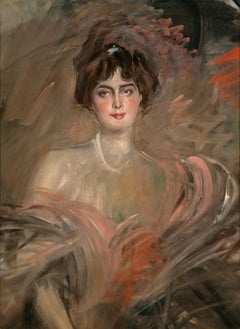Want more images or videos?
Request additional images or videos from the seller
1 of 9
Nicolas NeufchatelPortrait of Valentin KötzlerDated 1564
Dated 1564
About the Item
- Creator:Nicolas Neufchatel (1527-1590, Flemish)
- Creation Year:Dated 1564
- Dimensions:Height: 46.75 in (118.75 cm)Width: 41 in (104.14 cm)
- Medium:
- Movement & Style:
- Period:
- Condition:
- Gallery Location:New Orleans, LA
- Reference Number:Seller: 31-16301stDibs: LU1866629282
About the Seller
5.0
Vetted Professional Seller
Every seller passes strict standards for authenticity and reliability
Established in 1912
1stDibs seller since 2013
20 sales on 1stDibs
Typical response time: 4 hours
Authenticity Guarantee
In the unlikely event there’s an issue with an item’s authenticity, contact us within 1 year for a full refund. DetailsMoney-Back Guarantee
If your item is not as described, is damaged in transit, or does not arrive, contact us within 7 days for a full refund. Details24-Hour Cancellation
You have a 24-hour grace period in which to reconsider your purchase, with no questions asked.Vetted Professional Sellers
Our world-class sellers must adhere to strict standards for service and quality, maintaining the integrity of our listings.Price-Match Guarantee
If you find that a seller listed the same item for a lower price elsewhere, we’ll match it.Trusted Global Delivery
Our best-in-class carrier network provides specialized shipping options worldwide, including custom delivery.You May Also Like
Original abstract oil painting by prominent searchable artist Steve McElroy.
By Steve McElroy
Located in Dallas, TX
This artist's butterfly work is in the current Veranda Magazine with Jan Showers.
"Girl with the Hermes Scarf" by Steve McElroy. Oil on canvas, 22 x 28 inches, painted 2025. This ...
Category
2010s Renaissance Figurative Paintings
Materials
Canvas, Oil
$1,100
H 28 in W 22 in D 0.5 in
Fine 17th C Italian Old Master Oil Painting Madonna & Infant Christ with Joseph
Located in Cirencester, Gloucestershire
The Holy Family
17th century Genoise School, unsigned as typical of the period
follower of Luca CAMBIASO
oil on canvas, unframed
canvas: 29.5 x 22 inches
inscribed verso
Provenance: ...
Category
17th Century Renaissance Figurative Paintings
Materials
Oil, Canvas
Copy of "Portrait of Beatrice dʼEste" by Leonardo da Vinci created 15th Century
Located in New York, NY
A masterful copy by an unknown artist, after the portrait of "Beatrice d'Este" by Leonardo Da Vinci also known as ‘Portrait of a Lady’ or ‘La Dama con la reticella di perle (The Lady With a Pearl Hairnet)’. The original work originally created in the 15th Century is currently on display in the Pinacoteca Ambrosiana Museum of Milan. Beatrice d'Este was the Duchess of Bari/Milan and was believed to be one of the most attractive princesses of the Renaissance. Her impeccable style won her many admirers throughout Italy and France, and she became a trendsetter of the highest order. This copy of the original painting, is an oil on canvas done in the 18th Century, and in this exquisite portrait, the artist has masterfully depicted the fine details with draped hair, pearls, royal dress, ornate headgear and sumptuous jewelry in front of a dark background. Once again, capturing the imagination with another enigmatic smile. It comes housed in an elegant period giltwood frame with ebonized trims and ready to be displayed with hanging wire on verso.
Art measures 28 x 18 inches
Frame measures 34.5 x 24.5 inches
There is much debate and controversy over who actually painted the "Beatrice d'Este" was it Leonardo da Vinci (1452–1519), or Giovanni Ambrogio de Predis (1455–1508). So we may never know who executed the original portrait which hangs in the museum, but that need not deter from an appreciation of its singularity. Following the portraiture convention established by painters of the Quattrocentro, the artist has chosen to portray his sitter in profile. In doing so, he magnificently captures the essence of his sitter, a girl on the threshold of womanhood. Bedecked in the adornments—silk, velvet, pearls and embroidery (brocade) crafted of spun gold threads—afforded her by birthright and marriage, Beatrice looks forward in noble serenity. And at the same time her profile with its upturned nose and slight smile betrays an innocence that must have been the basis of the oft-repeated epithet: la più zentil donna in Italia” (“the sweetest lady in Italy”).
It is believed the lady is Beatrice d'Este (1475-1497), duchess of Bari and later of Milan, the wife of Ludovico Sforza (known as "il Moro"). One of the most beautiful princesses of the Italian Renaissance, she was known for her good taste in fashion. Beatrice was a member of the Este-Sforza family, which joined by marriage two of the oldest reigning and already powerful houses in Italy. The house of Este, which held court in Ferrara, traced its lineage to the 11th century Dukes of Saxony and Bavaria. Beatriceʼs father, Ercole I ruled the Ferrara commune for 34 years, catapulting the city-state (and the Estes with it) to an unmatched level of economic prosperity and cultural prominence. The family was renowned for its love of letters and patronage of the arts.
The first time Leonardo da Vinci’s name resounded in the Ambrosiana, it was through the pen of its founder, Cardinal Federico Borromeo, who attributed this little panel to the great Master, describing it as “A portrait of a Duchess of Milan, by the hand of Leonardo”. Following the Cardinal’s statement, the portrait was for long assumed to depict Beatrice d’Este, the wife of Ludovico il Moro. However, scholars have recently been more cautious and vague in their statements, with regard to both the artist (anonymous Lombard or Emilian...
Category
18th Century Northern Renaissance Portrait Paintings
Materials
Canvas, Oil
$35,000
H 34.5 in W 24.5 in D 2.5 in
19th Century Young Irish Woman with Feathered Hat
Located in Soquel, CA
Mid 19th Century portrait of a young Irish woman in c. 1570s dress with ruffle. Painted in the style of William Merritt Chase. Unsigned and unframed.
Category
Mid-19th Century Renaissance Portrait Paintings
Materials
Canvas, Oil
Ritratto con paesaggio
Located in Mokena, IL
Riratto con Paesaggio, 2019
Oil on Panel with Frame, 11 x 14 inches
A quiet and contemplative portrait painting, "Ritratto con Paesaggio", by Justas Varpucanskis, presents a sooth...
Category
21st Century and Contemporary Renaissance Portrait Paintings
Materials
Oil
Eli
Located in Mokena, IL
Eli, 2020
Oil on Panel with Carved and Gilded Frame, 11.5 x 13.5 inches
An embodiment of Renaissance portraiture, Varpucanskis’s “Eli” is distinguished by its gentle charm and mat...
Category
21st Century and Contemporary Renaissance Portrait Paintings
Materials
Gold Leaf
Flemish School--Girl in Chair-1631- Renaissance
Located in Brooklyn, NY
This exquisite oil painting on wood, created by an unknown Flemish artist in 1594, depicts a young girl seated in a chair. The artwork is in very good condition, though some modest r...
Category
16th Century Renaissance Paintings
Materials
Oil
A portrait of John Poyntz, after Hans Holbein, ca. 1644 - 1674
By Hans Holbein
Located in New York, NY
A portrait of courtier and politician John Poyntz, after Hans Holbein, circa 1644 - 1674. This painting is based on a drawing by Hans Holbein, part of the drawings collection of the ...
Category
Mid-17th Century Renaissance Portrait Paintings
Materials
Oil, Wood Panel
$24,000 Sale Price
52% Off
H 12.8 in W 10.44 in
Holy Woman, after Quentin Matsys penitent Saint Magdalene master copy
Located in Norwich, GB
A stunning copy of the Northern Renaissance masterpiece "Maddalena Dolente" by Quentin Matsys (1466-1530) which is in the collection of the Gemäldegalerie Berlin. Beautifully execut...
Category
Mid-20th Century Northern Renaissance Figurative Paintings
Materials
Oil, Wood Panel
$600
H 13.39 in W 11.42 in D 1.58 in
Renaissance Style Head Profile Portrait of Christ Beautiful Antique Oil Painting
Located in Cirencester, Gloucestershire
The Head of Christ
19th Century Dutch School
oil on paper laid down on board, unframed
size: 7.5 x 6 inches
private collection
The painting is in overall very good and sound condition
Category
19th Century Renaissance Figurative Paintings
Materials
Oil
More From This Seller
View AllSaint Cosmas And Saint Damian Attributed To Bonifacio Bembo
By Bonifacio Bembo
Located in New Orleans, LA
Attributed to Bonifacio Bembo
c.1444-1477 Italy
Saint Cosmas and Saint Damian
Tempera on panel
These exceptionally rare early Renaissance panels of Saint Cosmas and Saint Damian are an extraordinary new discovery. Based on the research of art historians Marco Tanzi and Andrea de Marchi, it is believed that these represent the missing panels from the famed polyptych formerly displayed on the altar of the Chapel of San Nicola da Tolentino in the Church of Sant’Agostino in Cremona, Italy. To find two matching early Renaissance panels outside of a museum or church, particularly in such remarkable condition, is an extraordinary rarity.
The central and left-sided panels of the original five-part polyptych are currently in the collection of the Museo Civico Ala Ponzone in Cremona. These panels have luckily remained intact, and respectively portray the Madonna and Child Enthroned with Angels and Donor, Saint Nicholas of Tolentino (the chapel’s namesake) and Saint George.
While the present panels have since been reduced, that they belong to the Cremonese altarpiece is confirmed by a number of stylistic elements. All five panels contain the same rich decorative arabesque pattern on their stamped gold background, while the figures’ knurled haloes are identical in both their fineness of line and use of perspective. The proportions of the figures coincide perfectly; Saints Cosmas and Damian would have originally also been depicted as full-length figures, fitting into the vertical, Gothic style of the altarpiece.
According to the Christian religion, Saint Cosmas and Saint Damian were 3rd century physicians born in Arabia. Little is known about their lives except that they were reputedly twin brothers and that they were martyred in Syria during the persecution of Emperor Diocletian. It was believed that the saints were skilled in healing, and when their medicines failed, their faith and prayers could always perform miracles. Thus, the saints are often depicted with their medical equipment while wearing the traditional medieval doctor’s garb of crimson robes and distinctive round red hats.
The saints are similarly depicted in the present panels, though considering the manner in which they have been cut, their medical tools are not immediately evident. The saints were highly popular as patrons of wealthy families during the Gothic and Renaissance eras, particularly the Medici, and thus they occur frequently in art from the era. The twins, for instance, are found in the famed San Marco Altarpiece by Fra Angelico in the San Marco Museum (Florence), as well as in a set of Medici panels crafted by Filippo Lippi...
Category
15th Century and Earlier Renaissance Portrait Paintings
Materials
Tempera, Panel
Portrait Of Dr. Frederick A. Cook By Albert Operti
Located in New Orleans, LA
Albert Ludwig Operti
1852-1927 Italian-American
Portrait of Dr. Frederick Albert Cook
Oil on canvas
This highly rare portrait of the important Polar explorer, Dr. Frederick Albert Cook, is the work of American artist Albert Ludwig Operti. Renowned in the late 19th and early 20th centuries for his paintings of exploration, namely Arctic scenes, Operti was the only artist to accompany Robert Peary...
Category
20th Century Realist Portrait Paintings
Materials
Canvas, Oil
L'Hortensia by Jean Pierre Cassigneul
By Jean-Pierre Cassigneul
Located in New Orleans, LA
Jean-Pierre Cassigneul
b.1935 French
L'Hortensia
(The Hortensia)
Signed “Cassigneul” (lower right)
Oil on canvas
Jean Pierre Cassigneul’s L'Hortensia captures an elegant woman se...
Category
21st Century and Contemporary Modern Portrait Paintings
Materials
Canvas, Oil
Portrait of Emilienne Le Roy by Giovanni Boldini
By Giovanni Boldini
Located in New Orleans, LA
Giovanni Boldini
1842-1931 Italian
Portrait of Emilienne Le Roy
Oil on canvas
A dazzling display of Giovanni Boldini’s signature style, Portrait of Emilienne Le Roy captures the ...
Category
20th Century Modern Portrait Paintings
Materials
Canvas, Oil
Solitude
By Guillaume Seignac
Located in New Orleans, LA
French Academic painter Guillaume Seignac was renowned for his masterful treatment of the idealized nude. His languishing female subjects based on Greco-Roman prototypes were and rem...
Category
19th Century Academic Nude Paintings
Materials
Canvas, Oil
Portrait of a Beauty by William Clarke Wontner
By William Clarke Wontner
Located in New Orleans, LA
William Clarke Wontner
1857-1930 British
Portrait of a Beauty
Signed and dated "W. Wontner 1918" (lower left)
Oil on canvas
Classical beauty a...
Category
20th Century Portrait Paintings
Materials
Canvas, Oil



